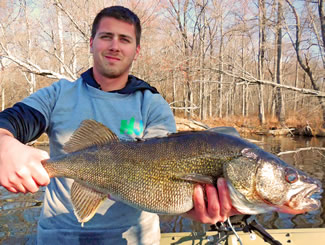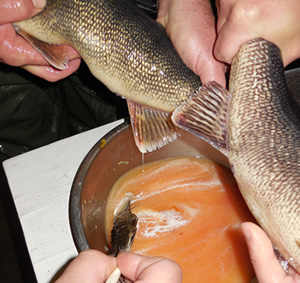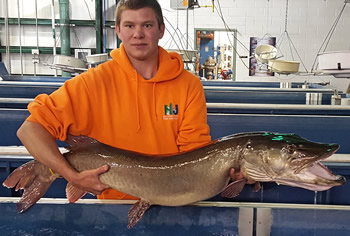|
Hackettstown State Fish Hatchery - 2016 Broodstock Collection
by Craig Lemon
Hatchery Superintendent
May 13, 2016
Having all winter to think about the previous two years of poor trap netting Northern Pike in Budd Lake, Hackettstown State Fish Hatchery staff decided to change things up a bit and set nets in Spruce Run Reservoir. Two years of record setting cold and ice without a single egg taken from Budd Lake in 2014 or 2015, and state fisheries biologist's trap netting success in Spruce Run Reservoir in 2015 made it an easy decision. Well if I was a baseball player it would be one, two, three strikes you are out! You'd think with almost 30 years doing this I would have all of the answers. Mother Nature rules!
|
The Hackettstown crew set four South Dakota style trap nets in Spruce Run Reservoir on March 7th and fished them for a week, pulling them Friday, March 11th. The nets captured 18 Northern Pike, 15 males and three females. The three small females were not ripe and never spawned.
As part of the Division's multi-year coolwater fishery assessment, Bureau of Freshwater Fisheries biologists kicked off their 2016 sampling with Budd Lake. Three South Dakota style trap nets were set on March 8th and fished through March 11th capturing over 100 Northern Pike! Hatchery staff met the boat at the ramp each day and picked up all of the females that had been captured.
Hatchery staff spawned a mix of Spruce Run and hatchery male pike with 27 ripe Budd Lake females and filled six McDonald hatching jars with a total of 654,534 eggs. The females averaged 24.242 eggs per fish. Northern Pike eggs hatch in 10 days in 52 degree water. The eggs hatched at a success rate of 59% just shy of the long term average of 60%. Once hatched Northern Pike grow fast! The pike are already four inches and will be stocked in June when they reach the targeted stocking size of 6-7 inches.
Having had good success with Northern Pike eggs and with the weather and water temperatures warming up, staff decided to begin Walleye broodstock collection efforts in Swartswood Lake on March 15. With high hopes of repeating the past two years' catches of 259 and 581, the crew set our "go to" trap net in the mouth of Neldon Brook.
|
|
Hopes quickly dropped the next morning with the capture of only one Walleye and one unhappy beaver. The beaver(s) apparently had chewed multiple holes in the trap net allowing the Walleye broodfish to escape. The second day yielded similar results, only capturing seven Walleyes and more beaver issues. Staff decided not to take any chances and set a second net off a shallow rocky point as a backup. With a cold front approaching and dropping water temps staff decided for the first time ever to zip tie the trap nets open for the weekend and stay off the water.
First thing Monday morning hatchery staff hitched up the boat and headed for Swartswood Lake to close up the trap net bags and start catching Walleyes again. Water temperatures had dropped from 46 degrees to 39 degrees over the weekend. Over the next few days with water temps hovering in the mid 40s and despite continued beaver problems, netting slowly picked up capturing 16, 11, 34, 57, and 32 adult Walleyes for a total of 163 fish over the ten-day period. There were 107 males and 56 females. The Walleyes averaged 3.7 pounds and 20.6 inches overall. The males averaged 2.86 pounds and 19.3 inches, while the females averaged 5.34 pounds and 23.2 inches. This is the largest average size for females since the hatchery began broodstock collection in Swartswood Lake in 2000. We did not hit the peak of the spawning season as in the past few seasons, but 41 of the 56 (73%) females did spawn producing 4.7 million eggs.
|
|
The 41 females averaged 115,620 eggs per fish, the highest total ever. Hatching success was 59%, one percentage point higher than in 2015. Walleye eggs hatch in 15 days. Hatchery staff then set up 500,000 two-day old fry into one large hatchery pond (4 acres) for grow-out and another 1.33 million fry were stocked in the Delaware River between Milford, PA and Belvidere, NJ. The expected hatchery pond production of Walleye fingerlings is about 100,000 two-inchers and 35,000 four-inchers.
Our focus then turned towards Muskellunge. With water temperatures holding in the low to middle 40s, hatchery staff chose to keep trap nets out of the water for the next ten days to allow the temperature in the shallow southern end of Greenwood Lake to rise closer to the magic 50-degree mark triggering female muskie eggs to ripen for spawning.
On April 5th, the crew set two Pennsylvania Style trap nets, one near the mouth of Belcher's Creek and a second across the lake in a spot known as the "State Land Set". The nets were checked 7 times over the next ten days with a few days off for a weekend cold front to pass. The nets captured an impressive 34 muskies (9 male and 25 female). The nets also captured a good number of big Walleye, Yellow and White Perch, Alewives, Black Crappies, and sunfish. Water temperatures ranged between 43 and 52 degrees.
The males averaged 16.8 pounds and 34.1 inches, while the females averaged 19.5 pounds and 42.1 inches. Of the 25 females captured, three came in ripe, 15 unripe, and 7 spent. A total of 13 were spawned in the hatchery yielding 612,677 eggs, an average of 47,129 per female.
|
At the same time hatchery staff were checking trap nets on Greenwood Lake, fisheries biologists were setting and checking trap nets on Echo Lake Reservoir. On a return trip from Greenwood Lake April 8th, the hatchery crew stopped by Echo Lake and picked up a couple of big ripe females, one over 50 inches and 33 pounds, the second or third biggest muskie ever spawned at the hatchery. The nets were left open over the weekend and hatchery staff took over checking the Echo nets on Monday, April 11th, as biologists turned their focus to Northern Pike on Pompton Lake. The three nets were fished through April 14th, capturing another 5 muskies. The nets also caught nine non-target species such as sunfish, crappies and Yellow Perch, Largemouth and Smallmouth Bass. Water temperatures held at 47 degrees.
Between the two lakes, a total of 20 female muskies were spawned producing about 1.7 million eggs. The eggs are currently still hatching in Hackettstown, but if the hatching percentages remain close to the first few jars (58%, 70%, 75%, and 60%) there should be a lot of muskie fry in 2016. Hatching success in 2015 was low with 31%.
|
Once hatched the fry spend the next 7 to 10 days basically lying on the bottom of the tank feeding off their yolk sacs (sac fry). Once the yolk sac is absorbed, after ten days, they are able to lift off the tank bottom and become free swimming (swim-up fry). The next 15 days are tough when we begin to convert a high percentage of muskie fry onto dry pelleted diets. This conversion consists of cooking and hatching small batches of brine shrimp eggs and feeding the shrimp five times per day to the muskie fry. This includes through the night. Muskies, unlike pike and tigers, insist on eating a moving food source as opposed to the dry feed just slowly dropping straight down through the water column.
The tiny fry are fed 15 days of live brine shrimp, each day mixing in more dry feed, slowly weaning the fry off the shrimp at the end of the two-week period. As the fry are growing, particle size of the feed is increased every couple of days, and the fish begin to go for the larger pellets as soon as they are introduced. By this time hopefully a good percentage (>80%) will have taken to the dry food diet. This helps greatly in reducing cannibalism. The muskie fry are raised both indoors in hatchery tanks and outdoors in earthen ponds. The target number is 12,000 ten-inch fingerlings by November 1st.
|
|
All adult muskies handled at the hatchery over the past nine years have been tagged with orange streamer tags inserted near the base of the dorsal fin. The tags bear the message "CALL HACKETTSTOWN HATCHERY (908) 852-4950" along with a tag number. Anglers who call in to report catching a tagged fish will be told when the fish was tagged, and its length and weight at the time of tagging. Reports of tagged fish provide the hatchery and state fisheries biologists with important growth information on the state's Muskellunge fisheries.
In coordination with fisheries biologists from the Bureau of Freshwater Fisheries, the Hackettstown Hatchery is raising the following numbers of Northern Pike, Muskellunge, and Walleyes to meet the state's needs for 2016:
25,500 six-inch Northern Pike fingerlings for stocking in:
Cranberry Lake (Sussex County); Pompton Lake and Pompton River (Passaic County); Spruce Run Reservoir (Hunterdon County); Budd Lake (Morris County); Farrington Lake (Middlesex County); Deal Lake (Monmouth County); Millstone River and the Passaic River.
12,000 ten-inch Muskellunge fingerlings for stocking in:
Greenwood Lake, Monksville Reservoir and Echo Lake Reservoir (Passaic County); Lake Hopatcong (Morris and Sussex counties), D&R Canal 10-mile stretch (Somerset and Mercer counties); Manasquan Reservoir (Monmouth County); Carnegie Lake and Mercer Lake (Mercer County); Mountain Lake and Furnace Lake (Warren County); Shenandoah Lake (Ocean County); Little Swartswood Lake (Sussex County); and DOD Lake (Salem County).
100,000 two-inch & 35,000 four-inch Walleye fingerlings for stocking in:
Lake Hopatcong (Morris County), Swartswood Lake (Sussex County), Greenwood Lake (Passaic County), Canistear Reservoir (Sussex County), Monksville Reservoir (Passaic County) and the Delaware River (Sussex and Warren Counties).
The Hackettstown State Fish Hatchery also raises 13 other species of fish for waters throughout the state - see the hatchery's production and stocking summaries for details. All fish raised at the Hackettstown Hatchery are stocked in public waters throughout the state to provide recreational fishing for licensed anglers and their families.
The hatchery also raises several species of fish to assist the state's mosquito control efforts. The hatchery stocks 2-3 million fish annually. The Hackettstown Hatchery is supported entirely through the sale of fishing licenses and federal Sport Fish Restoration Program grant monies generated from the sale of fishing equipment.
Below are summary tables of fish collected in spring, 2016.
NORTHERN PIKE
| WATERBODY |
# DAYS NETS WERE SET |
# FISH CAUGHT |
AVERAGE LENGTH (INCHES) |
LARGEST FISH (INCHES) |
AVERAGE WEIGHT (POUNDS) |
LARGEST FISH (POUNDS) |
| SPRUCE RUN RESERVOIR |
4 |
18 |
24.8 |
29.8 |
3.7 |
6.7 |
MUSKELLUNGE
| WATERBODY |
# DAYS NETS WERE SET |
# FISH CAUGHT |
AVERAGE LENGTH (INCHES) |
LARGEST FISH (INCHES) |
AVERAGE WEIGHT (POUNDS) |
LARGEST FISH (POUNDS) |
| GREENWOOD LAKE |
7 |
34 |
34.1 |
48.1 |
16.8 |
28.9 |
WALLEYE
| WATERBODY |
# DAYS NETS WERE SET |
# FISH CAUGHT |
AVERAGE LENGTH (INCHES) |
LARGEST FISH (INCHES) |
AVERAGE WEIGHT (POUNDS) |
LARGEST FISH (POUNDS) |
| SWARTSWOOD LAKE |
8 |
163 |
20.6 |
26 |
3.7 |
7.44 |
RELATED PAGES
|



